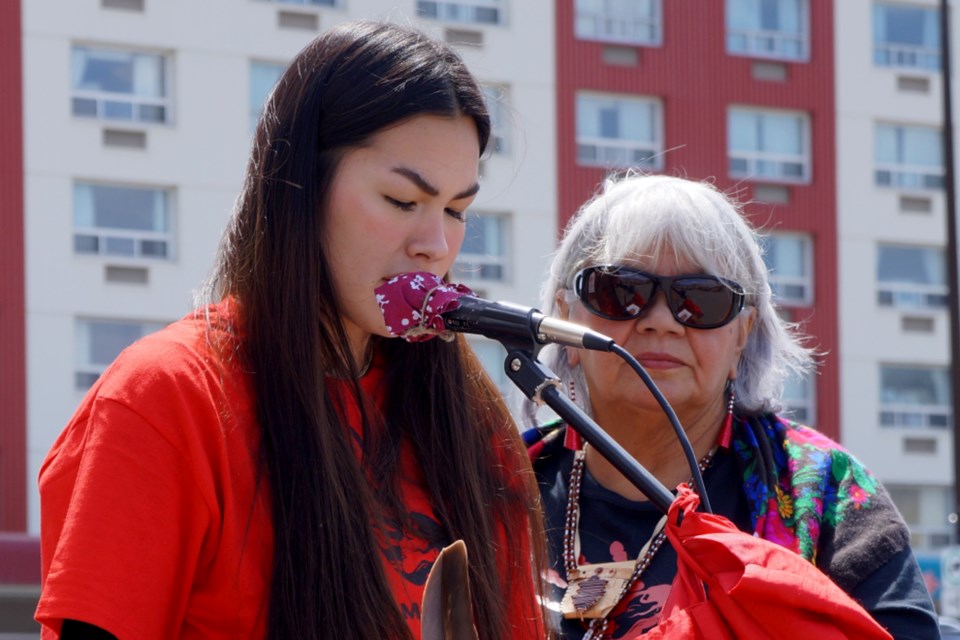On the National Day of Awareness for Missing and Murdered Indigenous Women and Girls, May 5, a new art piece was unveiled on the side of the N’Swakamok Native Friendship Centre in downtown Sudbury.
Commonly known as Red Dress Day because the symbol for MMWIG is a red dress, a colour Indigenous cultures link with the spirit world, and the phrase “No More Stolen Sisters.”
It is a call to action, and to support, for those who have been working to investigate and support the missing and murdered women who, for so long, were forgotten and left without justice.
More than 100 people came to the event, held outside the N’Swakamok Native Friendship Centre. With a sea of red and ribbon skirts, attendees listened to speakers who each held an eagle feather and a bundle of semaa (tobacco) as they spoke.
Marie Meawasige, executive director of N’Swakamok, spoke about the project, as did Shannon Agowissa and Juliette Wemigwans, as well as Hope Osawamick, daughter of one of the leaders of the project, Lisa Osawamick. Hope Osawamick read a poem written by her mother for the event, which you can find below.
The art piece was created by M’Chigeeng First Nation’s Kathryn Corbiere of One Kwe Modern Fabrications and commissioned through the Looking Ahead to Build the Spirit of Our Women – Learning to Live Free from Violence project in collaboration with Greater Sudbury Police and the N’Swakamok Native Friendship Centre. Funded by Justice Canada, the partnership has been in place since 2015.
The event was opened with prayers from elder Martina Osawamick, as well as singing and drumming from the Women’s Drum Group. After the ceremony, attendees were invited to share in soup and ‘scon’ (fry bread).
When her turn at the podium came, Wemigwans spoke of her sister, who lost her life in 2002 to domestic violence. Wemigwans' words came through tears, but she said the unveiling of the project is “so good for the people. It's bringing their thoughts, their voices, and their prayers to the forefront.”
She said the art piece would ensure that the missing and murdered women, girls and two-spirit would never be forgotten.
“When the community and the families bring forth this dress, it's no longer of a sight. It's no longer out of mind,” said Wemigwans. “There's an acknowledgment. Yes, I hear you. Yes, I see you, Yes, your voices are heard.”
Wemigwans said that while the image will be an emotional one to see, it is important.
“You're gonna see people coming here with prayer, and honoring their loved ones,” she said. “You're also going to see people coming here with grief, feeling the loss of that loved one; and you’ll see people coming here with anger, because their loved ones' lives have been taken.That’s why we bring this symbol to the forefront: yes, you're bringing all of that, but it's important that we share.”
Destiny Nootchtai and Aiyanna Gonawabi, 16-year-old members of Atikameksheng Anishnawbek, were at the event because they felt it was important to attend.
“It's something that we face … in our community,” said Nootchtai. “I know people that this has happened to, they've gone missing, so I feel it’s important to be here to support each other, come together and acknowledge everyone's trauma and history.”
Gonawaei agreed, and added the importance of raising awareness, even after years of calls to action.
“I know a lot of people who've never heard of this, the red dresses,” said Gonawaei. “It was pretty sad, because it needs to be out there more. So I feel like coming here, raising awareness, is really helpful.”
Part of that help and support was brought by Weecheetowin Support Services, (pronounced Wee-cheet-owin), formerly known as the Ontario Indian Residential School Support Services (OIRSSS). Weecheetowin translates to working together.
Offering support to anyone in attendance who felt they needed emotional support, Weecheetowin counselors Marley Martin and Dolores and Harvey Trudeau met with visitors in the teepee built onsite just for the event.
“We’re a shoulder to lean on because we've experienced these sorts of things,” said Harvey Trudeau, elder and residential school survivor. “We also provide our medicine: sage and smudge and eagle feather.”
Dolores Trudeau was very pleased at the turnout, which she called a “reunion.”
“I think we're supporting each other, which is really good, and it's bringing together not only one community, but the whole nation,” said Trudeau.
“We all understand each other because we came from the same background: we came from the residential school era, the day schools and then the babies that were taken away from the homes. We have to make sure they (the community) understand that, they have to know who they are and where they come from. And once they know that, then the healing and mending is there. We're all here helping each other and healing each other.”
The art installation can be seen outside the main entrance of N’Swakamok Native Friendship Centre at 110 Elm Street.
I Am Medicine.
By Lisa Osawamick
I am a rooted Anishinaabe-Kwe
I am a proud daughter of a mother who is a survivor of Indian residential school.
I am nurturing mother and a Nokomis. I'm a healthy, healing home.
I am medicine.
I am no longer my trauma; not the beaten.
I'm no longer the broken, not the drunk.
I'm no longer the loss, not the risk.
I am medicine.
I am a little girl laughing and picking berries with my Nokomis
I am a teenager completing her berry fast.
I'm a mother carrying her children in the tikinaagan.
I'm a Nokomis singing with my granddaughter into the circle of life.
I am medicine.
Jenny Lamothe is a reporter with Sudbury.com. She covers the diverse communities of Sudbury, especially the vulnerable or marginalized, including the Black, Indigenous, newcomer and Francophone communities, as well as 2SLGBTQ+ and issues of the downtown core.
